
views
Choosing a Topic for Your Narrative
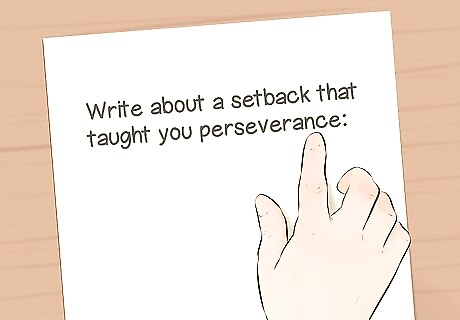
Read your assignment to identify the prompt and expectations. It’s best to read over the assignment more than once so you know exactly what it’s asking you to do. Note if there’s a prompt or a question you need to answer. Additionally, review the listed requirements for receiving full credit. If your instructor provides a rubric, read over it thoroughly to identify the expectations for full credit. Later, you can measure your essay against the rubric before turning in the assignment. If you have questions about the assignment, ask your instructor for clarification.

Brainstorm potential story ideas for your narrative. At first, let your ideas flow freely without trying to narrow your topic. Choose whether you want to write a personal or fictional narrative. Once you’ve got a good list of potential topics, you can choose one that works for you. For example, you might write about the first time you slept over at a friend's house, the day you brought home your first puppy or a fictional story about a boy who is struggling to build a fire for his campsite. Here are some ways to brainstorm ideas: List the first thoughts that come to mind when you think about the prompt or question. Make a mind map to sort out your ideas. Use freewriting to uncover story ideas. Simply write whatever comes to mind without worrying about grammar or making sense. Make an outline to help put your ideas in order.

Choose a single meaningful event to detail in the story. Review your list of ideas to find an event that fits the assignment. Then, narrow down your topic to a single, specific incident so the event fits into a single essay. Don’t try to cover too much in one essay, as this will be too hard for your reader to follow. For example, let’s say the prompt reads: “Write about a setback that taught you perseverance.” You might want to write about an injury you overcame. To narrow down your story, you might focus on the first time you exercised your injured limb after the accident, as well as the difficulties you faced.

Decide on a theme or message for your story. Relate your story idea back to the prompt, and think about how the story makes you feel. Additionally, consider how you want the reader to feel after they read your essay. Based on the answers to these questions, identify a core theme or message for your story. For instance, the story about recovering from an injury might have a theme of overcoming hardships or persevering to reach a goal. You might want your reader to finish your story feeling inspired and uplifted. To achieve this feeling, you'd want to focus on your successes throughout the process and end the story with a positive thought.
Planning Your Story
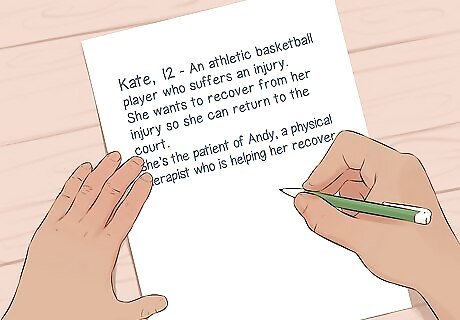
List and describe the characters in your story. Start with your main characters, writing out their name, age, and description. Then, identify the characters’ motives, desires, and relationships with each other. After you’ve created this character sketch for your main characters, create a brief list of any side characters you’ll include, as well as the important details about them. If you are a character in your story, you will still need to complete this step. It's up to you how much detail you want to write down about yourself. However, it's helpful to take note of your description, interests, and desires at the time the story takes place, especially if a lot of time has passed. A main character description might look like this: “Kate, 12 - An athletic basketball player who suffers an injury. She wants to recover from her injury so she can return to the court. She’s the patient of Andy, a physical therapist who is helping her recover.” A side character description might read like this: “Dr. Lopez is a friendly, fatherly middle-aged doctor who treats Kate in the emergency room.”

Describe the setting of your story in a few brief statements. Identify the different locations where your story takes place, as well as the time period when they occur. Write down every setting you'll include in your story, though you may not describe them all in the same amount of detail. Then, jot down a few descriptors that you associate with the location or locations. For example, a story about overcoming a sports injury might include a few settings, such as the basketball court, the ambulance, the hospital, and a physical therapy office. Although you want to show your reader each setting, you'll spend the most time on the main setting of your story. You might list the following descriptors about the basketball court: “squeaky floor,” “roar of the crowd,” “bright overhead lights,” “team colors in the stands,” “smell of sweat and sports drinks,” and “wet jersey sticking to my back.” Your story may feature several different settings, but you don't need to provide the same level of detail about each one. For instance, you may be in an ambulance for a brief moment in the scene. You don't need to fully describe the ambulance, but you might tell the reader about "feeling cold and alone in the sterile ambulance."

Map out the plot of your story with a beginning, middle, and end. A narrative essay usually follows a typical story arc. Begin your story by introducing your characters and setting, followed by the incident that hooks readers into the action of the story. Next, present the rising action and climax of your story. Finally, describe the resolution of the story and what your reader should take from it. For example, you might introduce a young basketball player who is about to make a big play. The incident that kicks off the story might be her injury. Then, the rising action is the basketball player’s efforts to complete physical therapy and get back into the game. The climax might be the day of tryouts for the team. You might resolve the story by having her find her name on the team list, at which point she realizes she can overcome any obstacle. It’s helpful to use Freytag’s triangle or a graphic organizer to plan your essay. Freytag's triangle looks like a triangle with a long line to its left and a short line to its right. It's a tool that helps you plan out your story's beginning (exposition), an incident that starts your story's events, the rising action, a climax, the falling action, and the resolution of your story. You can find a Freytag's triangle template or a graphic organizer for your narrative essay online.
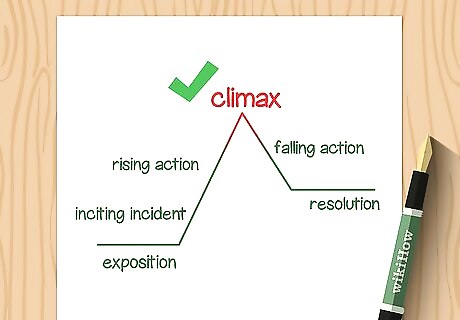
Write out the climax of your story either in detail or as an outline. The climax is the highest point in your story. The beginning and most of the middle of your story will build up to this point. Then, the end will resolve the conflict that drives your climax. The most common types of conflict include person vs. person, person vs. nature, and person vs. self. Some stories will have more than one type of conflict. In the story about the young athlete who gets injured, her conflict might be person vs. self, as she’s having to push through her pain and limitations.

Choose a point-of-view for your story, such as 1st person or 3rd person. Your point-of-view is going to depend on who is telling the story. If you’re telling a personal story, your point-of-view will always be 1st person. Similarly, you might use a 1st person point-of-view if you're telling a story from your character's perspective. You’ll use a 3rd person point-of-view if you’re telling a story about a character or another person besides yourself. In most cases, a personal narrative will use the 1st person “I” point-of-view. For example, “Over my last summer with my grandfather, I learned more than how to fish.” If you’re telling a fictional story, you might use the 3rd person point of you. Use your character’s name, as well as the appropriate pronouns like “he” or “she.” For instance, “Mia picked up the locket and opened it.”
Writing Your Introduction
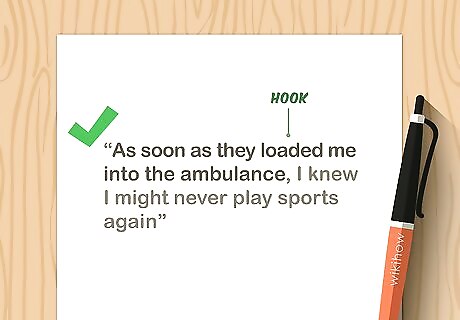
Begin your essay with a hook to engage your reader. Open your story with a sentence or 2 that pull in your reader. To do this, craft a hook that introduces your story’s topic and suggests what you’ll say about it. Here are some techniques to hook your reader: Start your essay with a rhetorical question. For instance, “Have you ever faced losing something that’s important to you?” Give a quote that fits your essay. You might write, “According to Rosa Gomez, ‘You don’t know how strong you are until a setback breaks you.” Provide an interesting fact that’s related to your story. As an example, “About 70% of kids will stop playing sports by the age of 13, and I was almost one of them.” Use a short anecdote that relates to the larger story. For your essay about overcoming an injury, you might include a short story about your best moment playing sports before your injury. Start with a shocking statement. You might write, “As soon as they loaded me into the ambulance, I knew I might never play sports again.”

Introduce the main characters in your story. Your reader needs a clear idea of who the story is about. Name and briefly describe the main characters in your story. You don’t need to tell every single detail about them in the introduction, but your reader should have a general idea about who they are. Let’s say your main character is you. You could write, “As a tall, lean 12-year-old, I easily outplayed the other girls on the court.” This gives the reader a picture about what you might look like, as well as your interest in sports and athletic ability. If you’re telling a fictional story, you might introduce your character like this: “As she walked toward the high school debate podium, Luz exuded confidence from her Kate Spade headband down to her thrift shop Betsey Johnson pumps.” Not only does this help the audience picture Luz, but it also shows that she puts effort into her appearance. The fact that she shops at thrift stores might indicate that her family isn’t as wealthy as she portrays.
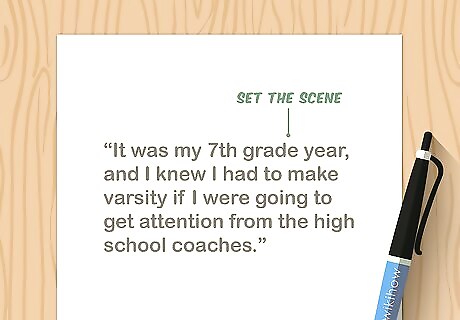
Describe the setting to set the scene for your story. The setting includes the when and where of the story. Specify when your story takes place. Additionally, provide sensory details to help the reader experience the location. You might write, “It was my 7th-grade year, and I knew I had to make varsity if I were going to get attention from the high school coaches.” Sensory details trigger your senses of sight, hearing, touch, smell, and taste. As an example, “My shoes squeaked across the court as I dribbled toward the goal line, the red basket in sight. Sweat made the ball feel slippery against my fingertips, and its salty taste coated my lips.”

Include an overview of the story and its theme in the last sentence. You might also preview the events in the story, depending on what works best for your narrative. This statement will act as your thesis for your narrative essay. It tells your reader what to expect from your essay but doesn’t spoil the story. For instance, you might write, “I never expected that pass across the court to be my last for the season. However, recovering from my injury taught me I’m a strong person who can accomplish anything I set out to do.”



















Comments
0 comment